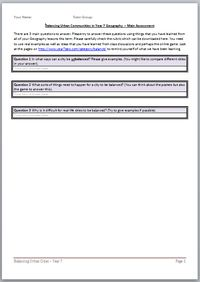4) Balancing Urban Communities Assessment
 and
and  and
and 
Here is the worksheet which you must download, save a copy and complete by the deadline set by your teacher. Click on the picture of it to download it:
Here is the rubric but you can also download a copy by clicking here.
Some help:
Question 1: In what ways can a city be unbalanced? Please give examples. (You might like to compare different cities in your answer).
Here are three top tips:
1) When it says ‘ways’, you can organise your answer into some of the different criteria (headings) we used for the poster. To see the poster again visit this page and scroll down to about halfway down.
http://www.year7geo.com/2-how-balanced-are-cities-2/
You can even have subtitles, such as:
1 – Employment and Income
2) When it says ‘unbalanced’, think of the examples your group came up with for your city’s poster that were coloured red (unbalanced). You can also use information from other groups that covered the same city, and you can even use information from the other city if you want – but this is not necessary. To see some examples from two Year 7 classes go here and look at the answers that are red in particular: http://www.year7geo.com/2-part-b-example-student-work/
3) Finally, if you want to gain a particularly good score for this question, make sure you refer to different areas and places in the city using their name (such as ‘the Dharavi slum’) or general location (such as ‘East Inner London’). You can refer to places that have much better access to things like employment and those that have much worse access to the same things and you can then show how this shows things are not balanced. Give real facts and figures that have already been researched.

nice website!